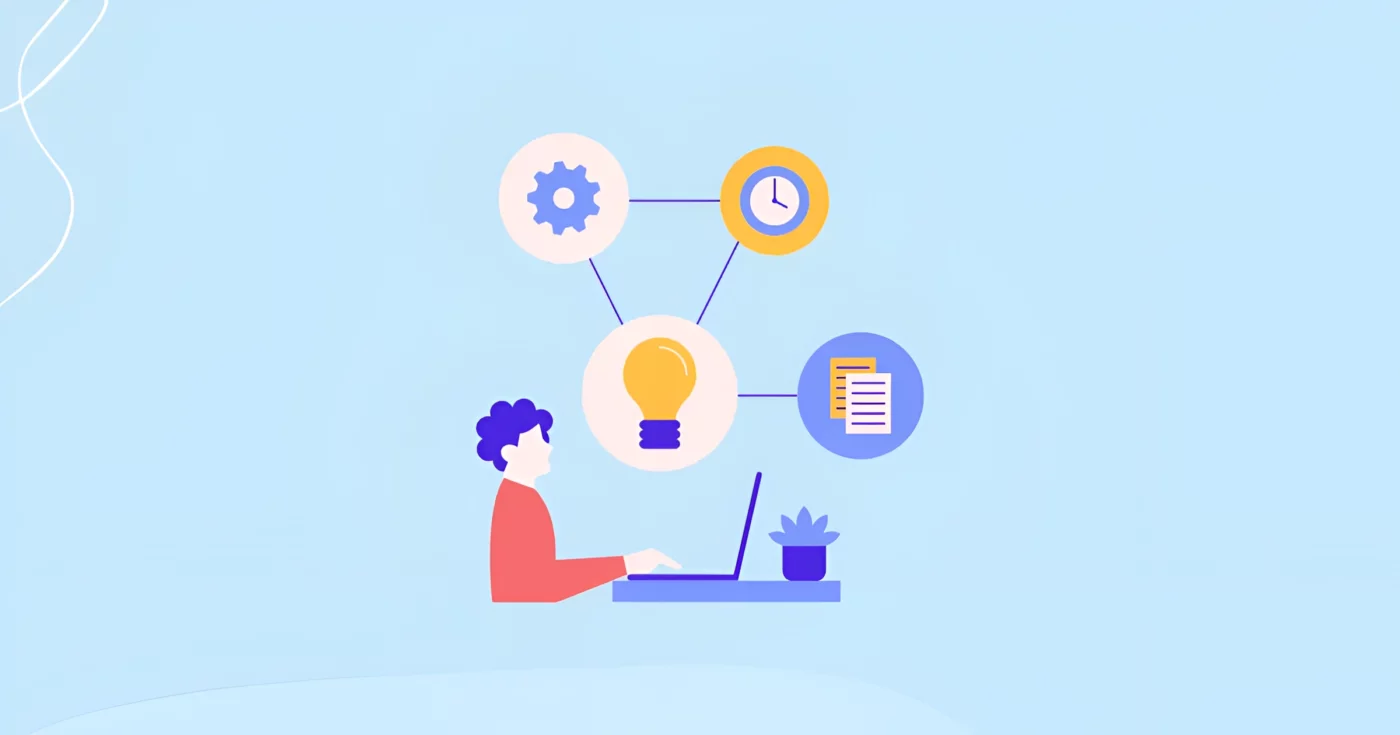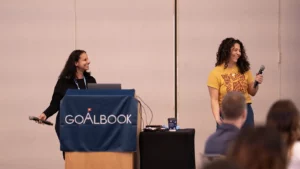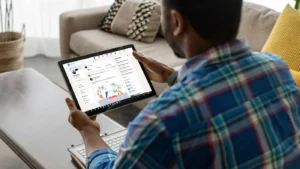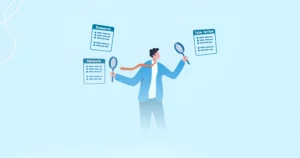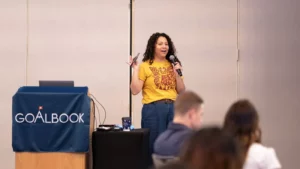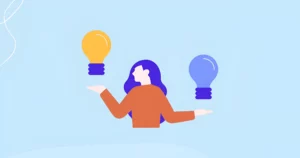Have you ever had an interview when you wished you would have said something differently?
Have you ever gotten nervous in an interview because your mind went completely blank after you were asked a question?
Have you ever forgotten what question you were answering in the middle of an interview?
If you identify with any of these scenarios and have felt stressed or uncomfortable during an interview, know that you’re not alone. 92% of U.S. adults are stressed by at least one thing about the interview process (Global News Wire).
While the stress and anxiety associated with interviewing can make the interview itself feel like it’s out of your control, there are steps you can take to prepare for a remote job interview and feel more comfortable during the interview.
I sat down with Goalbook’s Talent Acquisition team, Purva Dandona and Veronica Lucena, to get the following best practices for things you can do before, during, and after any interview to help you feel more in control and confident.
Best Practices Prior to an Interview
Best Practice #1: Before an Interview, Do Some Research.
Once you’ve been invited to an interview, it’s time to do some research. Lucena gives a couple ideas of what to research before your interview:
- Research what the company has been doing.
“Two places to find information about a company are 1) on the company’s webpage and 2) on the company’s LinkedIn page,” says Lucena. Look for the company’s mission and what the company does so that you can refer to both during the interview. Can you find projects they’ve accomplished or blogs/articles they’ve recently posted that you can speak to? What about their mission resonates with you? Lucena adds, “Doing this research will also help solidify whether you think the company will be a good fit for you, not just if you are a good fit for them.” - Know who you’re talking to and why.
Lucena stresses the importance of knowing who you are talking to and why because “it will help you know what kind of questions to anticipate, what kind of questions to ask, and how to prepare your answers.” If you’re on LinkedIn, you can check the person’s profile to get a sense of their role and how long they’ve been with the company.
If you can’t find much information on LinkedIn about the person you’re interviewing with, Lucena says, “It’s okay to ask for more information about the person.” She suggests that if you’re unsure who you’ll be speaking to, send an email to whoever contacted you and write something like, “I may have missed information about whom I am meeting. Can you give me more information?”
The recruiter or hiring manager has likely done some research on you as a candidate, so do some research on both the company and whom you’ll be speaking with.
Best Practice #2: Anticipate Commonly Asked Questions and Prepare Your Answers.
There are some commonly asked questions in an initial interview that you can anticipate. While it is unlikely you’ll know exactly what questions will be asked, if you spend time looking into what questions are common in an interview, you can start to feel more comfortable with how you may respond to the questions.
Here are just a few questions that you may be asked:
- Tell me about yourself.
- Why do you think you’d be a good fit for this role?
- Tell me more about xx on your resume.
There are many resources available with lists of commonly asked interview questions. For example, The Muse has a list of 50 possible questions and model responses to the questions.
Dandona says, “Don’t stop at solely looking into the commonly asked questions. You should also prepare your answers for those commonly asked questions.” Doing this will help you think all the way through your response, and it can also be something you refer to during your interview.
The STAR method is one solution to help you know how to answer possible questions:
- Situation: Lay the foundation for a story and give necessary details that will help illustrate your answer.
- Task: What was your responsibility in this situation?
- Action: What action steps did you take to accomplish the task?
- Result: What was the outcome of the situation?
“A key thing to consider as you’re preparing your answers is to be cognizant of how much time is scheduled for the interview,” Dandona says. Keep your answers brief but clear.
Best Practice #3: Thoughtfully Prepare Some Questions to Ask.
As you prepare for an interview, Lucena says to “reflect on why you are looking to change your job and why you’ve applied to the companies you have.” As you reflect, formulate questions that will help guide you in knowing if what you are seeking will be found in the company you’re interviewing with.
For example, are you currently in a role in which you feel there is not room to grow professionally in the direction you want? Then a question you may ask is: What opportunities for growth are in this position?
Or perhaps the position you’re currently in has little flexibility in work hours, and you’d like more. Then a question you may consider asking is: Tell me about what a typical work day looks like. Are there core hours that everyone must be working?
“Another important thing to consider is who you are talking to and where in the interview process you are,” Lucena states. If the initial interview is with a recruiter, you may want to ask more questions about the general feel of the company, culture, and role to make sure you would want to do that role and be a part of that company. If the initial interview is with a hiring manager, you can ask more specific questions about the role, what success in the role looks like, and how you would work together.
Lucena encourages you to use the opportunity to ask questions to truly investigate if this is a company you want to work for.
Best Practice #4: Do a Self-Check and a Tech-Check.
“How you show up for an interview is important,” Dandona says. “For a remote interview, be in a place where you can focus.” Dandona also suggests that if you have to take an interview in a place that is noisy, address that with whomever you’re interviewing (don’t pretend it’s not happening). If you have no choice but to do an interview from your car, please acknowledge the situation and why. Do not do this for an interview with the hiring manager or a final round interview.
Dandona provides the following suggestions for both a Self-Check and a Tech-Check before your interview:
Be fresh and ready to go. For your Self-Check, consider the following:
- Know what you’re going to wear. Have your interview outfit ironed and ready to go the day before. “Dressing up gets you mentally ready,” says Dandona.
- On the day of the interview, have everything that you’ll need to refer to during the interview: your notes that include the questions you prepared, your customized resume you used to apply to that job, the job description itself, and a way to write notes down during the interview. Dandona states that you may “tell the interviewer you have notes you’ll be referring to and that you will be writing things down during the interview.” If you can’t print these documents up, be sure you have the tabs open.
It is also important to do a Tech-Check before you login for an interview. Dandona recommends you perform your Tech-Check with enough time to problem solve in case you need to. Some ideas for your Tech-Check include:
- Practice with your lighting.
- Check your sound. If you have headphones, they’re good to use to help minimize ambient noises.
- Have a backup in case the internet is wonky. For example, keep your phone handy so that if there are internet problems or sound problems, the person doing the interview can call you. In this case, have your phone charged!
Dandona also says, “If you don’t have internet easily accessible, tell the recruiter so they can work with you on alternatives. We recruiters can get creative with options, so be sure to communicate with us.”
Best Practices During an Interview
Best Practice #5: Be Honest.
Lucena stressed the importance of honesty. There are ways to be both professional and honest in an interview.
Lucena says, “If you’re asked a question and don’t have the experience or don’t know what the interviewer meant, it’s okay to ask clarifying questions.” For example, if you’re asked the question “Tell me about yourself,” you can ask, “What specifically are you looking for?”
When we feel nervous and stressed in an interview, we may either get lost in a question or in an answer we’re giving. Lucena also wants to encourage you to be honest in those cases, too. She states, “It’s okay to say, “Let me think about that for a second.’” Lucena goes on, “And if needed, you can ask, “Can you share that question again?’”
Best Practice #6: Be Concise and Clear.
Best Practice #2 suggested preparing questions and answers ahead of time, and Dandona expands on that for when you’re in the interview. “Be aware of the amount of time that has been scheduled for the interview,” she states. “This will help you budget how long each of your responses may be.”
Practicing your answers out loud before the interview helps with your timing, can help prevent you from rambling, and sets you up to be concise and clear. You can summarize your work experience when sharing about it — you don’t have to list every company you’ve worked for or every role you’ve had. “Consider your key achievements, strengths, accomplishments and hone in on those in your answers,” Dandona says.
Best Practice #7: Breathe.
Interviews are nerve-wracking! The folks conducting the interviews are aware of this and have experienced it themselves.
Before you enter the interview, try practicing breathing on a four count: put both your feet on the ground and then inhale to the count of four, hold your breath to the count of four, and then exhale to the count of four. Control your exhale as much as you control your inhale and the holding of your breath.
Focusing on taking a couple of deep breaths before your interview helps to regulate your nervous system and promote emotional well-being. For more information on the benefits of taking a moment to focus on your breathing, check out this article.
Best Practices After an Interview
Best Practice #8: Write a Thank You Email.
Within 24 hours of your interview, send a thank you email to whomever you interviewed with. “If you don’t have the email address of someone you interviewed with, it’s okay to ask the recruiter or whomever else you’ve been in contact with for the interviewer’s email,” says Lucena.
Lucena offers the following ideas for a thank you email:
- Address it to the person you spoke with.
- Keep it short.
- Refer to something specific you spoke about.
- Reiterate why you would be a good fit or what you would contribute to the team.
Writing a thank you email is a good opportunity to build a relationship with the person you met and address things that came up in the interview. It may also help you to stay top-of-mind with the hiring manager.
Lucena and Dandona end with a few final thoughts. What it all comes down to is this: be courteous and communicate. Be honest and keep checking in with yourself during the process. If you don’t think the role or the company is a good fit for you, and you want to remove yourself from the candidacy, let your point of contact know immediately. In addition, if something comes up, and you can’t make it for your scheduled interview time, be sure to let the person know. Being considerate and communicating clearly will help you leave a positive impression no matter the outcome of the interview.
If you want more suggestions on applying for jobs, see our post “The Essentials of Applying to EdTech Jobs.”
Explore Goalbook’s open jobs on our Careers Page.
Follow us on LinkedIn to stay up to date on job opportunities.
Read stories about the Culture at Goalbook.
